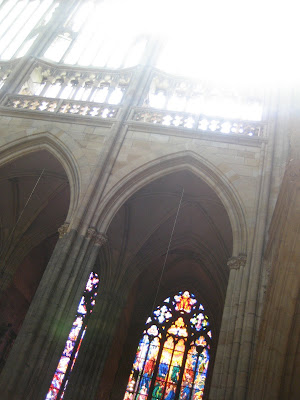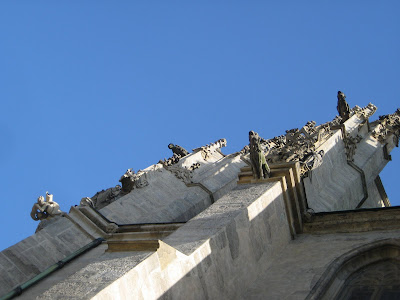


















This statue is of Master Jan Hus, the dean of the Charles University in Prague, criticized church practices such as selling indulgence. He used to preach in Prague and he was excommunicated by the pope for his ideas in 1410. Despite that, he continued in preaching and he had many followers in Prague, that´s why the pope interdicted the whole city of Prague in 1414. Finally, Jan Hus was invited to the Council in Constance and he was asked to renounce his ideas. He refused, and he was burnt at the stake as a heretic on 6 th July 1415.
The monument of Jan Hus at the Prague Old Town Square was designed by Ladislav Saloun. The foundation stone was laid down in 1903 and the monument was unofficially revealed on 6 thJuly 1915, the 500 th anniversary of Jan Hus´s death. A festive event was forbidden. Prague citizens covered the Jan Hus Monument with flowers.
The monument consists of Jan Hus statue and statues of Czech people around him.









Gargoyles. I have been obsessed with gargoyles since I saw them on a church in Prague in 2002. I have to admit my love of them comes straight from my Grandma Bell, her passion for creepy little things lives through me, hence my little man Tillman. On this trip, I have been overwhelmed by the amount of gargoyles on every church and thought it would be to my benefit to do some research about them.
Gargoyles:
They originated somewhere between the 11th and 13th century.
There are two types of Gargoyles; functional and non-functional. Non-functional, defined as a stone carving that resembles a creature but does not carry water is technically called a grotesque.
Gargoyle is defined as “a waterspout, projecting from an upper part of a building to throw water clear of walls and foundations.” The origin of the word ‘gargoyle’ is derived from a French word meaning ‘gargouille’ meaning throat.
Architecturally the only purpose of the gargoyle was to provide a method of drainage that protected the stones and the mortar of churches, cathedrals and castles from erosion.
Second purpose of the gargoyles was as ‘guardians’ to ward of evil.
No two gargoyles are exactly the same. The masons had free choice on the style and type of gargoyle to use.
Chybíš mi!













